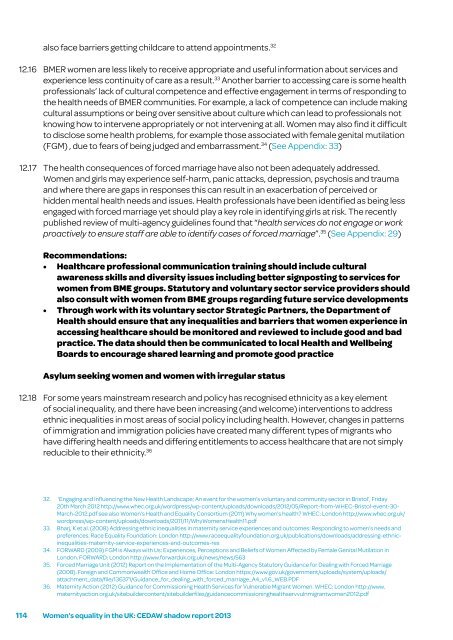Women’s equality in the UK – A health check
Women’s equality in the UK – A health check
Women’s equality in the UK – A health check
You also want an ePaper? Increase the reach of your titles
YUMPU automatically turns print PDFs into web optimized ePapers that Google loves.
12.16<br />
12.17<br />
12.18<br />
also face barriers gett<strong>in</strong>g childcare to attend appo<strong>in</strong>tments. 32<br />
BMER women are less likely to receive appropriate and useful <strong>in</strong>formation about services and<br />
experience less cont<strong>in</strong>uity of care as a result. 33 Ano<strong>the</strong>r barrier to access<strong>in</strong>g care is some <strong>health</strong><br />
professionals’ lack of cultural competence and effective engagement <strong>in</strong> terms of respond<strong>in</strong>g to<br />
<strong>the</strong> <strong>health</strong> needs of BMER communities. For example, a lack of competence can <strong>in</strong>clude mak<strong>in</strong>g<br />
cultural assumptions or be<strong>in</strong>g over sensitive about culture which can lead to professionals not<br />
know<strong>in</strong>g how to <strong>in</strong>tervene appropriately or not <strong>in</strong>terven<strong>in</strong>g at all. Women may also f<strong>in</strong>d it difficult<br />
to disclose some <strong>health</strong> problems, for example those associated with female genital mutilation<br />
(FGM) , due to fears of be<strong>in</strong>g judged and embarrassment. 34 (See Appendix: 33)<br />
The <strong>health</strong> consequences of forced marriage have also not been adequately addressed.<br />
Women and girls may experience self-harm, panic attacks, depression, psychosis and trauma<br />
and where <strong>the</strong>re are gaps <strong>in</strong> responses this can result <strong>in</strong> an exacerbation of perceived or<br />
hidden mental <strong>health</strong> needs and issues. Health professionals have been identified as be<strong>in</strong>g less<br />
engaged with forced marriage yet should play a key role <strong>in</strong> identify<strong>in</strong>g girls at risk. The recently<br />
published review of multi-agency guidel<strong>in</strong>es found that “<strong>health</strong> services do not engage or work<br />
proactively to ensure staff are able to identify cases of forced marriage”. 35 (See Appendix: 29)<br />
Recommendations:<br />
• Healthcare professional communication tra<strong>in</strong><strong>in</strong>g should <strong>in</strong>clude cultural<br />
awareness skills and diversity issues <strong>in</strong>clud<strong>in</strong>g better signpost<strong>in</strong>g to services for<br />
women from BME groups. Statutory and voluntary sector service providers should<br />
also consult with women from BME groups regard<strong>in</strong>g future service developments<br />
• Through work with its voluntary sector Strategic Partners, <strong>the</strong> Department of<br />
Health should ensure that any <strong>in</strong>equalities and barriers that women experience <strong>in</strong><br />
access<strong>in</strong>g <strong>health</strong>care should be monitored and reviewed to <strong>in</strong>clude good and bad<br />
practice. The data should <strong>the</strong>n be communicated to local Health and Wellbe<strong>in</strong>g<br />
Boards to encourage shared learn<strong>in</strong>g and promote good practice<br />
Asylum seek<strong>in</strong>g women and women with irregular status<br />
For some years ma<strong>in</strong>stream research and policy has recognised ethnicity as a key element<br />
of social <strong>in</strong><strong>equality</strong>, and <strong>the</strong>re have been <strong>in</strong>creas<strong>in</strong>g (and welcome) <strong>in</strong>terventions to address<br />
ethnic <strong>in</strong>equalities <strong>in</strong> most areas of social policy <strong>in</strong>clud<strong>in</strong>g <strong>health</strong>. However, changes <strong>in</strong> patterns<br />
of immigration and immigration policies have created many different types of migrants who<br />
have differ<strong>in</strong>g <strong>health</strong> needs and differ<strong>in</strong>g entitlements to access <strong>health</strong>care that are not simply<br />
reducible to <strong>the</strong>ir ethnicity. 36<br />
32. ‘Engag<strong>in</strong>g and Influenc<strong>in</strong>g <strong>the</strong> New Health Landscape; An event for <strong>the</strong> women’s voluntary and community sector <strong>in</strong> Bristol’, Friday<br />
20th March 2012 http://www.whec.org.uk/wordpress/wp-content/uploads/downloads/2012/05/Report-from-WHEC-Bristol-event-30-<br />
March-2012.pdf see also <strong>Women’s</strong> Health and Equality Consortium (2011) Why women’s <strong>health</strong>? WHEC: London http://www.whec.org.uk/<br />
wordpress/wp-content/uploads/downloads/2011/11/WhyWomensHealth11.pdf<br />
33. Bharj, K et al. (2008) Address<strong>in</strong>g ethnic <strong>in</strong>equalities <strong>in</strong> maternity service experiences and outcomes: Respond<strong>in</strong>g to women’s needs and<br />
preferences. Race Equality Foundation: London http://www.race<strong>equality</strong>foundation.org.uk/publications/downloads/address<strong>in</strong>g-ethnic<strong>in</strong>equalities-maternity-service-experiences-and-outcomes-res<br />
34. FORWARD (2009) FGM is Always with Us: Experiences, Perceptions and Beliefs of Women Affected by Female Genital Mutilation <strong>in</strong><br />
London. FORWARD: London http://www.forwarduk.org.uk/news/news/563<br />
35. Forced Marriage Unit (2012) Report on <strong>the</strong> Implementation of <strong>the</strong> Multi-Agency Statutory Guidance for Deal<strong>in</strong>g with Forced Marriage<br />
(2008). Foreign and Commonwealth Office and Home Office: London https://www.gov.uk/government/uploads/system/uploads/<br />
attachment_data/file/136371/Guidance_for_deal<strong>in</strong>g_with_forced_marriage_A4_v1.6_WEB.PDF<br />
36. Maternity Action (2012) Guidance for Commission<strong>in</strong>g Health Services for Vulnerable Migrant Women. WHEC: London http://www.<br />
maternityaction.org.uk/sitebuildercontent/sitebuilderfiles/guidancecommission<strong>in</strong>g<strong>health</strong>servvulnmigrantwomen2012.pdf<br />
114 <strong>Women’s</strong> <strong>equality</strong> <strong>in</strong> <strong>the</strong> <strong>UK</strong>: CEDAW shadow report 2013


